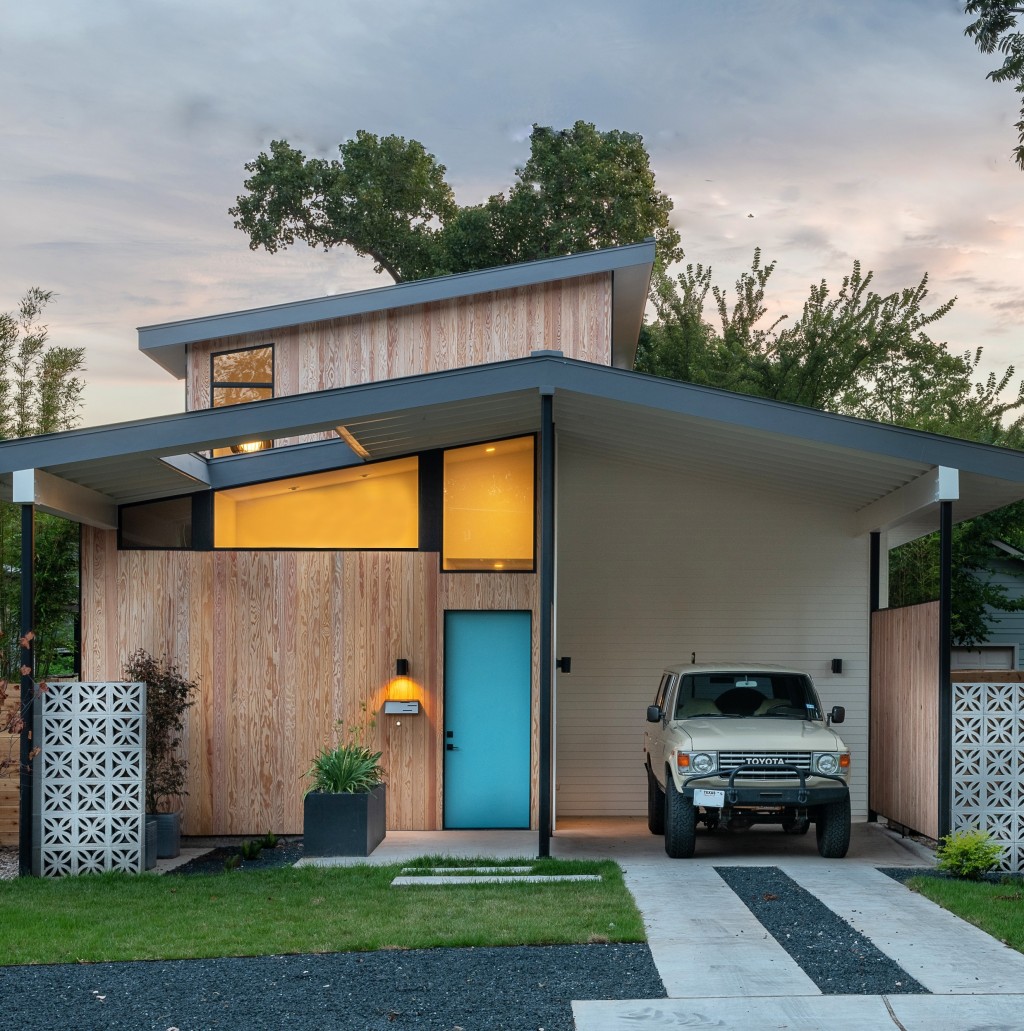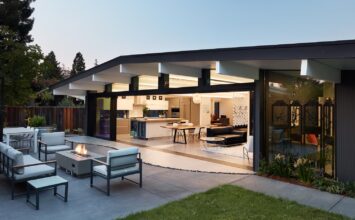The Split House reinterprets Mid-Century Modern for compact urban living in the Zilker neighborhood

The developer of this speculative house wanted the design to be accessible to everyone; it couldn’t be too specific for just a few, but also not too generic that it blends in with everything else. The ultimate goal was to create a home that presents the Mid-Century Modern look and feel (as many neighboring homes do) while creating enough space for a family. The resulting design of Split House incorporates elements of the Mid-Century Modern typology of its South Austin neighborhood through massing, scale, and materiality.
The urban infill lot where this home sits is typical of the neighborhood: long and narrow (approx. 140’ long and somewhat trapezoidal shaped with 52’ width at the front and 35’ in the back). Most homes built on lots like these are placed in the center of the lot with a front and back yard. However, due to local zoning laws, there is a limit to height. So, when you cannot build tall, you need to build long to give adequate space.
With the specific circumstances of the lot and request for accessibility from the client in mind, Matt Fajkus Architecture set forth by primarily answering this question: how do we build something on this site that optimizes the geometry of this lot? The answer: a central line that acts as a spine through the home from which the main circulation and all spaces are connected. The spine centers the home and organizes the layout from front to back with nonlinear interior and exterior living areas falling on either side; it also gives the home its name: Split House.

The elongated form of the home avoids the negatives of a central mass-style home where rooms often lose access to daylight and outdoor connections. By spreading the home out and orienting it along a central line, the views to outside are greater and indoor/outdoor connections throughout the first floor are more plentiful. In fact, because the way the formal living areas open to internal and external courtyards, the somewhat smaller living spaces inside are effectively doubled in size, while natural light and air flow are also completely maximized. Skylights and clerestory windows further enhance the indoor/outdoor connection throughout the house and harken back to the reverence for nature seen in Mid-Century Modernism.

In terms of residential architecture, Mid-Century Modern is characterized by humble roof lines, a consolidation of large solid and glass façade portions, and the use of natural materials. From the street, Split House sports a true humble Mid-Century Modern façade with an immediately noticed pitched, low-profile roof. By putting the second floor in the back of the home, it allows for a lower front with higher ceilings and the aforementioned skylights inside the common areas. It also affords privacy to the second-floor bedrooms by not abutting them to the street.
The central spine is immediately visible from the front in physical form of a support beam for the roof and a dividing line between the carport on the right and the home’s entrance on the left. The carport is classic Mid-Century Modern style and avoids the limitations of a garage. While it is seen at the front of the home (i.e. not hidden off to the side), it does not define the home’s appearance.

One thing the carport vs. garage choice forces is the single entry in the front. The family’s every day entry is the same for guests; there is no side/garage mudroom entrance. The home is experience by all who enter in the same manner.
The general material palette for the whole home is very straightforward. The front façade is defined by a combination of decorative cement breeze blocks in front, and strategically placed Douglas fir wood (on the left entrance side), balanced with traditional hardy board siding (in the right carport side). Windows above the entrance compliment the wood below and allow sunlight in through the slightly northwest-facing front of the home. The color palette of the interior has been kept minimalist. The floors are white oak, and the walls are mostly plain white drywall. This was a specific choice to allow the future owners to decorate the home to their lifestyle.
The front door is a beautiful shade of blue (called “Peacock Feathers”) that stands out from the colors of the front of the home, a welcomed Mid-Century Modern style choice: bold but purposed. A skylight in the roof over the entryway gives a glimpse of the taller structure in the rear.
Once inside the front door, a clear view straight through the entire home is immediately visible and the unique layout is noticed. Staggering off the central line allows for pockets of natural light and indoor/outdoor spaces. In fact, every room of the home captures light from at least two different angles. Every season and every day, the whole house gets plenty of sunlight, much of it via RAM Windows.


To the immediate left is a small office nook, perfect for a family computer and office related storage. A small powder room is also in this first room. Past the nook, still on the left side of the center line is a small outdoor courtyard/exterior pocket for the home. The outdoor space is just the right size for outdoor dining and is a huge source of natural light.
Moving past this group of spaces, visitors enter the kitchen and dining area. The two rooms are adjacent to each other, spreading horizontally across the center line. No second floor above the kitchen and dining rooms means ceilings can be higher to give the feel of expanded space, and skylights can be placed for direct overhead sunlight; in the kitchen a horizontal window provides additional light.
The kitchen is equipped with Thermador appliances and features quartz countertops, tiled backsplash, and walls maximized for storage with white oak and painted paneling. The rear facing wall is a sliding glass door that gives access to the “side yard” and pool.
Actually, every main room on ground floor has immediate access to outside; the living room, kitchen, and master bedroom all have Western sliding doors that open to the yard, while the dining room has access to the small courtyard, which is perfect for outdoor dining. This layout plays a huge role when entertaining. The staggered positioning of spaces with fully open doors on a nice day extends the living space through the entire lot. It’s also worth noting that all sliding doors are the same height, thus presenting a datum line for consistency throughout the home.
Visitors can move down along the central spine through a short corridor, past the stairwell, and into the living room. Sliding doors on the right provide the indoor/outdoor connection and a frosted clerestory window on the left offers sunlight while retaining privacy for the family. A gas fireplace helps keep the room cozy on chilly nights.
To the left of the fireplace, behind a closed door, is the entrance to the final portion of the ground floor: the master suite. The bedroom is a modest size, but more importantly has direct access to the yard. Having the doors open on a nice morning is a great way to start the day. The large ensuite bathroom and adjoining walk-in closet offer residents the option to keep the bedroom free of clutter and clothing.

Stepping outside to explore the rear – or “side yard” – visitors can further see the effectiveness of the central spine. The front portion of the home stretches the width of the lot. But after the kitchen/dining area, an exterior wall follows the spine with the two-story structure on one side and plenty of patio space with a 24’ long in-ground pool on the other. Because the ground floor of the spine is lined with tall windows and sliding glass doors, the outdoor space feels incredibly connected to the indoor spaces.
The home’s design of two stories along a stark, lengthy, vertical central line could have fallen into the trap of feeling like the side of a barn. Matt Fajkus Architecture, however, made choices for some aesthetic considerations by incorporating a design and mix of materials to separate the mass and provide an eye-pleasing and interesting look. The ground floor is hardy board and glass. The second floor uses the datum line and horizontal cues of the windows to provide three ribbons of materials: exterior wood on the top and bottom lines and a center row of windows and vertical wood cladding. The result is both functional sharp looking.
Back inside and up the stairs to the second floor where visitors will find the only traditional hallway in the home, which has been lined with windows to bring in the sunlight. There are three bedrooms up here. The first two smaller rooms share a Jack-and-Jill bathroom. At the end of the hall, a third bedroom has its own bathroom and could be used as a proper home office or private guest room.


There are two window placements worth noting. Upstairs, as visitors walk down the hallway, at the end (in the third bedroom) a window has been placed as a focal point to avoid the feeling of walking towards a finite space. Likewise, guests may not notice it as they ascend the stairs, but as they come back down, a large window placed at the bottom of the stairwell gives a view of the yard, rather than a solid wall. Decision like these play a huge role in keeping the home well lit and giving that sense of expanded space throughout.

Matt Fajkus Architecture’s Split House allows lots of function without sacrificing form. The first floor is porous with air circulation and indoor/outdoor connections, while retaining privacy for the residents. The second floor, “hidden” in the back, gives enough space on this small urban lot for a family to live comfortably. Developer spec homes can get a bad reputation when they are hastily plopped down in cookie-cutter fashion, but the Split House is a wonderful example of how a spec home can be designed and built with careful thought and excellence.
Matt Fajkus Architecture
Based in: Austin, Texas
Contractor/Builder: Central Props
Photographer: Casey Woods
Neighborhood: Zilker
Bedrooms: 4
Bathrooms: 4
Approximate Square Footage: 2520
Year built: 2019
Flooring: White oak
Windows: RAM Windows
Glass walls/panes: Western
Countertops: Quartz
Cabinets:
Appliances: Thermador
Plumbing Fixtures: Grohe, Signature Hardware, Kohler, Duravit
Lighting: Kovak, Kichler, Mitz, Kuzco, WAC
Exterior materials: Douglas Fir Siding, Standing Seam Roofing, Breeze Blocks







